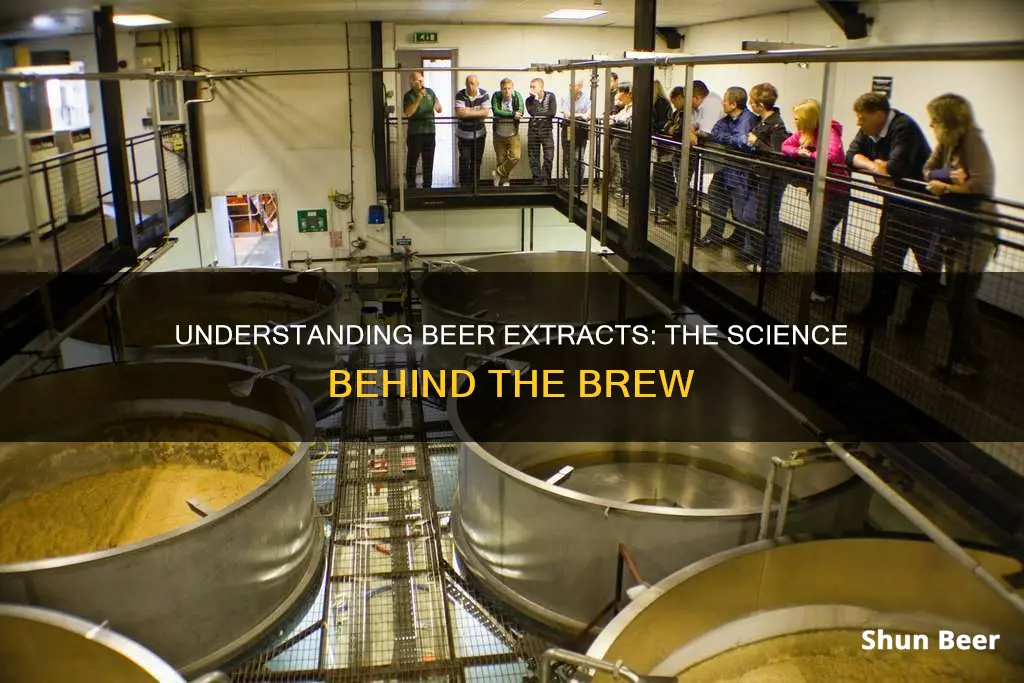
Beer is made from malted barley which has been mashed to produce a sweet liquid called wort. Yeast feeds on the sugars in the wort to produce alcohol and carbon dioxide. The process of crushing grain and mixing it with water is known as mashing. You mash grains to release starches as sugars. The malted grains are soaked in water at a specific temperature for a specific amount of time—a process known as “mashing” or “the mash”—which extracts the fermentable sugars from the grains, so yeast can ferment them into alcohol and ultimately create beer.
Malt extract is made by taking the liquid collected during a mash and dehydrating it either into a thick syrup or dry-powdered form. This dehydrated liquid collected from a standard mash is what we call a beer extract.
What You'll Learn

The benefits of brewing with malt extract
Brewing beer with malt extract offers several benefits for homebrewers, from saving time and space to achieving consistency in the final product. Here are some advantages of using malt extract for brewing:
Saves Time
The use of malt extract eliminates the need for the time-consuming all-grain mashing process, which involves heating water, soaking grains, lautering, and sparging. This process can take up to six hours or more for a full all-grain brew day. In contrast, brewing with malt extract can be completed in as little as two to three hours, making it a convenient option for those with busy schedules.
Saves Space
By skipping the all-grain mashing process, brewers can also reduce the amount of equipment needed. Traditional all-grain brewing often requires a large mash tun and an extra boil kettle. With malt extract brewing, a single pot is usually sufficient, taking up less space and requiring a smaller investment in equipment.
Efficiency and Consistency
Malt extract provides a predictable amount of fermentable sugars when added to water, making it easier to hit target gravity. All-grain brewing can be tricky as it involves controlling mash temperatures and volumes to extract the desired amount of sugars. Malt extract simplifies this process, resulting in more consistent results and reducing the chances of errors.
Encourages New Homebrewers
Malt extract brewing is an excellent way to introduce people to the world of homebrewing. It is easier to grasp, more cost-effective, and less intimidating for beginners. By skipping the mashing process, new brewers can focus on understanding the basics of brewing and developing their skills over time.
Versatility and Convenience
Malt extracts come in a wide range of colors and formats, allowing brewers to create almost any style of beer they desire. Whether it's a light and crisp pilsner or a dark and malty stout, malt extracts offer versatility in flavor and style. Additionally, malt extracts are produced with high-quality brewing malts, ensuring that the final beer is of good quality.
Beer, Anxiety, and You: A Curious Concoction
You may want to see also

The process of making malt extract
Once the mash is complete, the sugary-sweet wort is sent through a pipe to a filter. The filter helps to separate the spent grain sediment, while the sediment-free wort is sent to holding tanks. If the malt extract is hopped, it will often undergo a boil in one of these tanks to promote isomerization.
From the tanks, the wort is sent to evaporators. This is where the process starts to differ from a typical homebrew day. The evaporators remove 80% of the wort's water content, leaving a syrupy, 20% liquid malt extract. Dry malt extract requires one additional step where the evaporated malt extract is sent through a centrifuge to further separate water from the malt, resulting in a powder-like substance.
Malt extract is made by mashing and dehydration. It is a powerful homebrewing ingredient, especially for beginners, as it removes some of the variables like hitting mash temperatures and volumes.
Morning Beer: Should You Drink Before Work?
You may want to see also

The differences between liquid and dry malt extract
The primary difference between liquid and dry malt extract is the amount of water in each. Liquid malt extract (LME) is made by conducting a typical mash and then dehydrating the wort down to about 20% water. What is left is a goopy, molasses-like syrup. Dry malt extract (DME) is created the same way as LME but goes through an additional dehydration step, reducing the water content down to about 2%.
Because of the difference in water content, a pound of liquid extract and a pound of dry extract differ in sugar content. This means that liquid and dry extract are not interchangeable in a recipe. However, there is a simple formula to convert between the two: 1 pound of dry malt extract is roughly equivalent to 1.2 pounds of liquid malt extract, and vice versa.
Liquid malt extract is generally cheaper, easier to store, transport, and package, and offers a slightly wider range of flavours. However, it can be difficult to pour and measure out smaller quantities. Many brewers also report that LME makes darker beers and is more prone to degradation over time, which can lead to off-flavours.
Dry malt extract, on the other hand, offers more fermentable extract by weight, meaning you need less of it to achieve a target gravity. It is also easier to measure into precise increments and tends to have a better shelf life without the darkening issues of liquid malt extract. However, the dry form of DME can be hygroscopic, meaning it absorbs moisture and clumps together when exposed to air or steam. This can make it challenging to work with.
Ultimately, the choice between liquid and dry malt extract depends on the brewer's personal preference, equipment, skill level, and other factors. Both types of malt extract have their merits and drawbacks, and it is possible to create great beer with either type, as long as the extract is fresh and stored properly.
Krusteaz Buttermilk: The Perfect Beer Batter Base?
You may want to see also

How to brew with malt extract
Brewing with malt extract is a great way to make beer at home for beginners and experienced brewers alike. It is a much quicker and more efficient process than all-grain brewing, and it still produces great beers. Here is a step-by-step guide on how to brew with malt extract.
Firstly, malt extract comes in liquid or dry form. Liquid malt extract (LME) is similar to molasses in consistency, while dried malt extract (DME) is like a fine powder. The type of malt extract depends on the grains used. Before you begin, warm up your liquid malt extract to make it thinner and easier to pour. A warm water bath at 150-160°F/65.5-71°C for 20 minutes should do the trick.
Next, you will need to prepare your ingredients and equipment. The basic equipment includes a large pan, a strainer, digital scales, a fermenting bin, a syphon, a hydrometer, a paddle, a steraliser, and a thermometer. In terms of ingredients, you will need water, malt extract, hops, and yeast. You can also add herbs and spices to experiment and create unique blends, but be cautious as strong flavours can ruin your beer.
Now you are ready to begin brewing. Start by heating your water to between 65-70°C. If using crushed malt grains, steep these for 30 minutes to add colour, sugar, and flavour to your beer. Keep an eye on the temperature and add heat if it drops below 65°C. Then, remove the grains with a strainer.
Dissolve the malt extract in the water and bring to the boil. Add your hops, boiling for at least 20 minutes to sanitise the wort. Most recipes call for a 60-minute boil, with hops added at different times depending on the desired character. Hops added early will impart bitterness, while those added later will add flavour and aroma.
After boiling, cool the wort to yeast pitching temperature. Then, pitch the yeast and ferment the wort. For best results, leave the beer in the fermenter for 14 days. Finally, bottle or barrel your beer and wait for it to clear.
And that's it! You've brewed your own beer using malt extract. Remember to keep your equipment clean and sanitised, and always take your time to ensure the best results.
Understanding Beer Distribution: From Brewery to Glass
You may want to see also

The challenges of extract brewing
While extract brewing has many benefits, it also has its own set of challenges. Here are some of the key challenges and considerations to be aware of when extract brewing:
- Understanding your system: To brew consistently good beer, it's important to understand the details of your brewing system and how they affect the final product. Brewing an extract version of an all-grain beer or a clone of a commercial beer and comparing the two can help identify areas that need adjustment.
- Boil volume: Boiling the wort in a larger volume of water can improve the colour and hop bitterness of the beer. A full-volume boil is generally preferable to a partial boil as it offers more efficient hop extraction and is less likely to darken the wort.
- Wort darkening: Several factors can contribute to wort darkening, including the heat and duration of the boil, as well as the potential to caramelize partially dissolved malt extract. Controlling these factors can help prevent unacceptable darkening of the wort.
- Hop utilisation: Extract brewing can impact the amount of bitter substances (alpha acids) extracted from the hops. Adding hops loose to the brewpot and using a neutral high-alpha hops variety can help improve bitterness.
- Cooling the wort: It is important to cool the wort quickly and efficiently to protect the beer's flavour and clarity. Using a wort chiller or an ice bath can help achieve this.
- Water composition: The mineral composition of the water used in extract brewing can impact the final product. Using soft or distilled water can help reduce the risk of excess minerals affecting the beer's flavour.
- Yeast health: Ensuring healthy yeast is crucial to the success of extract brewing. Creating a yeast starter or obtaining yeast from another source, such as a previous fermentation or a brewpub, can help improve the quality of the beer.
- Specialty grains: While extract brewing limits unique malt-derived flavours, adding specialty grains can enhance the colour, flavour, mouthfeel, and bitterness of the beer. Steep these grains in hot water to create a "grain tea", but be sure to remove them before adding the malt extract to avoid releasing excess tannins.
- Technique: Proper technique is essential in extract brewing. Stirring the wort while adding the malt extract, warming the liquid malt extract, and stirring when using dried malt extract can help prevent scorching and clumping.
Viagra and Beer: A Safe Mix?
You may want to see also
Frequently asked questions
Beer extract is mashed grain. The process of crushing grain and mixing it with water is known as mashing. You mash grains to release starches as sugars. Mashed grain has had most or all of the water removed to create a concentrated extract.
Using beer extract saves time, space, and encourages new home brewers. It also saves space as less equipment is needed for brew day.
Beer extract comes in two forms: liquid or dry. Liquid malt extract (LME) has a thick, syrupy consistency and a water content of around 20%. Dry malt extract (DME) undergoes further dehydration to remove water and is easier to measure and store.







